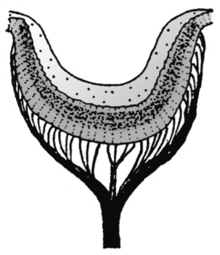Pigment cup ocellus

Pigment cup oocelles (synonyms: pigment cup eyes, pigment cup cells ) are simple light-sensing organs ( eyes ) that z. B. in strudelworms (Turbellaria) or lancet fish ( Branchiostoma lanceolatum ) occur.
They consist of 20 to 30 photoreceptors, which are arranged in a semicircular recess. Depending on the direction of the incident light, only a few photoreceptors are excited, so that the organism is able to perceive the direction of the light. As originally a special development of the epidermis , further developed pigment beaker ocelles also occur with an inverse (inward) or everse (outward) arrangement of the photoreceptors.
Like pit eyes , which also enable directional vision , pigment cup oocelles are more powerful light sensory organs than the simple eye spots (stigmas) of protozoa, which only enable light-dark vision, i.e. nothing more than perception of the direction of the incident light. Compared to the bladder and lenticular eyes , in which image vision is made possible, pigment cup ocelles are at a disadvantage.
See also
literature
- Wilfried Westheide, Reinhard Rieger (Hrsg.): Special zoology. Part 1: unicellular organisms and invertebrates. corr. u. additional reprint d. 1st edition, Spektrum Akademischer Verlag, Heidelberg, Berlin 2004, ISBN 3-8274-1482-2